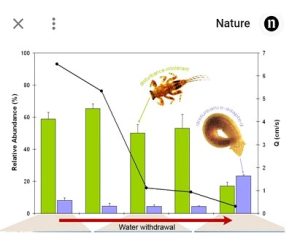Ass. Pro. Dr.: Israa Nasser Ghulam
Department of Biology
college of education for pure sciences
Bioindicators of pollution are measurable materials used to assess the presence or effects of pollutants in biological systems. These biomarkers are used to determine exposure levels, monitoring organisms’ response to contamination. The indicators are many and varied, for example specific enzyme activity genetic biomarkers, oxidative stress, Histopathological indicators, the most important indicators are bioaccumulation or biomagnification. [1,2] . The use of invertebrates as biological indicators provides valuable insights about pollution levels and the health of ecosystems, and these indicators help in evaluating the impact of some pollutants on this group and the surrounding environment. For example, can be measured Biological accumulation of pollutants by invertebrates, where invertebrates are characterized by their ability to retain and accumulate pollutants in their tissues, and this in turn provides monitoring of pollutant concentrations such as heavy metals or organic compounds. Pollution also changes the composition and diversity of invertebrate communities. Some species may become more dominant or their abundance decreases due to their sensitivity or tolerance to pollutants. Thus, changes occur in the structure of society and this serves as an indicator of the effects of pollution. [3,4]. Some groups of invertebrates show altered behaviors such as reduced feeding or changes in reproductive behavior. Observing these behavioral changes can indicate the presence of pollutants. Pollution may have physiological effects on invertebrates, for example, changes in their growth rates, reproduction, immune functions, and in general their general health [5]. These biological indicators, when monitored, analyzed and compared with environmental data, can give us a comprehensive understanding of the effects of pollution on invertebrate populations and their ecological communities.
Reffrence :
⦁ Depledge, M. H., et al. (2001). Biomarkers in Ecotoxicology: Past, Present, and Future. Biomarkers, 6(6), 413-416.
⦁ Adams, S. M., et al. (2005). Biomarkers of Environmental Contaminant Exposure in Fish. Environmental Bioindicators, 1(2), 120-137.
⦁ Forbes, V. E., et al. (2018). Integrating Ecotoxicology into Regulatory Decision-Making for Sustainable Chemical Management. Environmental Science & Technology, 52(22), 12820-12829.
⦁ Van Straalen, N. M., & Roelofs, D. (2006). An Introduction to Ecological Genomics. Oxford University Press.
⦁ Bervoets, L., & Blust, R. (2003). Metal Concentrations in Water, Sediment and Gudgeon (Gobio gobio) from a Pollution Gradient: Relationship with Fish Condition Factor. Environmental Pollution, 126(1), 9-19.






























































